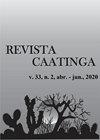巴西半干旱区地下坝区水电导率的空间变异
IF 0.9
4区 农林科学
Q3 AGRONOMY
引用次数: 0
摘要
地下水坝在巴西东北部的半干旱地区广泛部署,旨在缓解水资源短缺造成的影响。本研究评估了2018年旱季结束和2019年雨季结束时地下坝水电导率的地理分布。在ArcGIS 10.4.1软件中使用逆距离加权插值器创建地图。结果表明,所评价的地下坝电导率具有较高的变异性。除了位于Apodi和Severiano Melo市的两座水坝外,最大的数值出现在北部大州的东部。大多数地下坝(64%)的水电导率低,土壤盐碱化电位(EC < 0.7 dS - m-1)。结果表明,影响地下坝盐度的因素主要有气候、地形、坝区水系流域农村集聚和畜牧业的土地利用和占用,以及坝区精耕细作的施肥营养管理等。本文章由计算机程序翻译,如有差异,请以英文原文为准。
Spatial variability of water electrical conductivity in underground dam areas in the semi-arid region of Rio Grande do Norte, Brazil
ABSTRACT Underground dams have been widely deployed in the semi-arid region of Rio Grande do Norte, a state in the Brazilian Northeast, aiming to mitigate the effects caused by water scarcity. In this study, the geographic distribution of the electrical conductivity of water of underground dams was evaluated at the end of the dry season of 2018 and at the end of the rainy season of 2019. Maps were created in ArcGIS 10.4.1 software using the Inverse Distance Weighted interpolator. The results indicated high electrical conductivity variability in the evaluated underground dams. The highest values were obtained in the eastern portion of the Rio Grande do Norte state, except for two dams, located in the municipalities of Apodi and Severiano Melo. In most of the underground dams (64%), the water has an electrical conductivity with low soil salinization potential (EC < 0.7 dS m-1). It was observed that the salinity of the underground dams is influenced by several factors, such as climate, relief, land use and occupation due to rural agglomerations and animal husbandry in the dam hydrographic basin, and intensive nutritional management with fertilizers in the dam area.
求助全文
通过发布文献求助,成功后即可免费获取论文全文。
去求助
来源期刊

Revista Caatinga
AGRONOMY-
CiteScore
2.10
自引率
11.10%
发文量
67
审稿时长
6-12 weeks
期刊介绍:
A Revista Caatinga é uma publicação científica que apresenta periodicidade trimestral, publicada pela Pró-Reitoria de Pesquisa e Pós-Graduação da Universidade Federal Rural do Semi-Árido – UFERSA, desde 1976.
Objetiva proporcionar à comunidade científica, publicações de alto nível nas áreas de Ciências Agrárias e Recursos Naturais, disponibilizando, integral e gratuitamente, resultados relevantes das pesquisas publicadas.
 求助内容:
求助内容: 应助结果提醒方式:
应助结果提醒方式:


